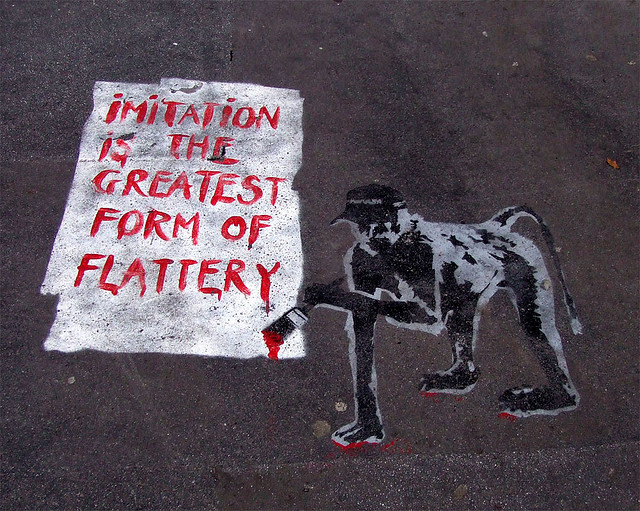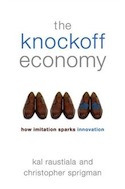
Copyright and patent law was established in the U.S. Constitution to offer both financial and creative protection for innovators. But according to legal scholars Kal Raustiala of UCLA and Christopher Sprigman of the University of Virginia, industries where copying isn’t regulated thrive not in spite of imitation but because of it. Raustiala visits Zócalo to discuss why copycats just might be good for all of us. Below is an excerpt from his and Sprigman’s book, The Knockoff Economy: How Imitation Sparks Innovation.
Innovation is central to our contemporary economy. And many people believe that the rules about copying that fall under the banner of “intellectual property”-in particular, copyright and patent-are the basis of sustained innovation. This belief in the power of intellectual property, or IP, predates the Internet, the computer, and even the lightbulb. It was also a central concern of the Framers of the U.S. Constitution. The Constitution explicitly grants Congress the power to create patents and copyrights for “limited Times” as a way to “promote the Progress of Science and useful Arts.”

In a market economy like ours, of course, we depend on competition to keep the price of goods and services low and their quality high. And a lot of competition involves copying. (Think of Pinkberry, whose success spawned Kiwiberry, Yogurt Land, and dozens of other stand-alone shops serving tart, frozen yogurt with mix-ins). So why do we allow prohibitions on copying, prohibitions that constrain competition? As the language of the Constitution suggests, we protect innovation from copying because innovation has good consequences, and restraints on copying are thought to be necessary for innovation to occur in the first place.
Some believe that these restrictions have an important moral dimension as well: copying the work of another, they say, is unfair and akin to stealing. The Framers generally took a different view. As Thomas Jefferson famously wrote, ideas are not like tables or televisions:
If nature has made any one thing less susceptible than all others of exclusive property, it is the action of the thinking power called an idea. … Its peculiar character, too, is that no one possesses the less, because every other possesses the whole of it. He who receives an idea from me, receives instruction himself without lessening mine; as he who lights his taper at mine, receives light without darkening me.
In other words, if we take your car, we have it and you do not. But to copy an idea takes nothing from the creator; the creator still has it and so too does the copyist. And this makes the copying of ideas more morally ambiguous than stealing ordinary tangible property like a car.
The primary reason the American legal system regulates copying, in short, is not moral but practical. Both copyright, which protects books, songs, films, and the like, and patent, which protects useful inventions such as medicines, machines, and business methods, rest on the theory that the control of copying is necessary for innovation to occur. Innovation requires rules that allow creators to control who can make copies-either by making the copies themselves, or selling licenses to others. Creators, in short, need a monopoly over the right to make copies. In this book, we refer to this as the monopoly theory of innovation.
Why is it thought that creators need a monopoly over their creations? Many innovations are difficult to invent but easy to copy. If copying is allowed, the monopoly theory holds, investment in new inventions and creations will be discouraged as copyists replicate the work of originators-and often more cheaply, since they do not bear the costs of creation. In Jefferson’s terms, if everyone is constantly lighting their taper from our flame, we might not bother to light our own taper in the first place.
The argument that copying stifles creativity is intuitively appealing. Who is going to create if others are free to take? Proponents of this view tend to assume that it is self-evident that strong patent and copyright laws are essential to keep creative juices flowing, and that more protection is better than less.
This is one reason that the term of protection under American copyright law has increased from 28 years in 1790 to over a century today. It is also one reason the scope of patents has expanded from things like cotton gins and chemicals to cover a wide, some would say absurd, range of ways of doing business-such as the patent on “one-click” purchasing awarded to online retailer Amazon. (Only the naïve would ignore another reason for this expansion: there is a lot of money at stake in controlling innovations, and those who possess the relevant rights have every incentive to push to make them as strong as they can.) The justification for the expansion of monopoly rights is simple: more intellectual property yields more protection, which in turn produces more creativity. Or so the story goes.
This book challenges the conventional wisdom about innovation and imitation. And it does so in a new way. Most of the debate on these issues has revolved around existing industries that are major proponents of strict rules against copying, such as the music business (copyright) or the pharmaceutical industry (patent). We instead explore a variety of industries and arts, like fashion, databases, and comedy, in which copyright and patent do not apply, or are not used. In other words, we ask, What happens when restrictions on copying are not part of the picture?
What we find is that even though others can freely copy in these industries, creativity remains surprisingly vibrant.
Reprinted from The Knockoff Economy: How Imitation Sparks Innovation with permission from Oxford University Press, Inc. Copyright © 2012 by Oxford University Press.
*Photo courtesy of grahamc99.




Send A Letter To the Editors